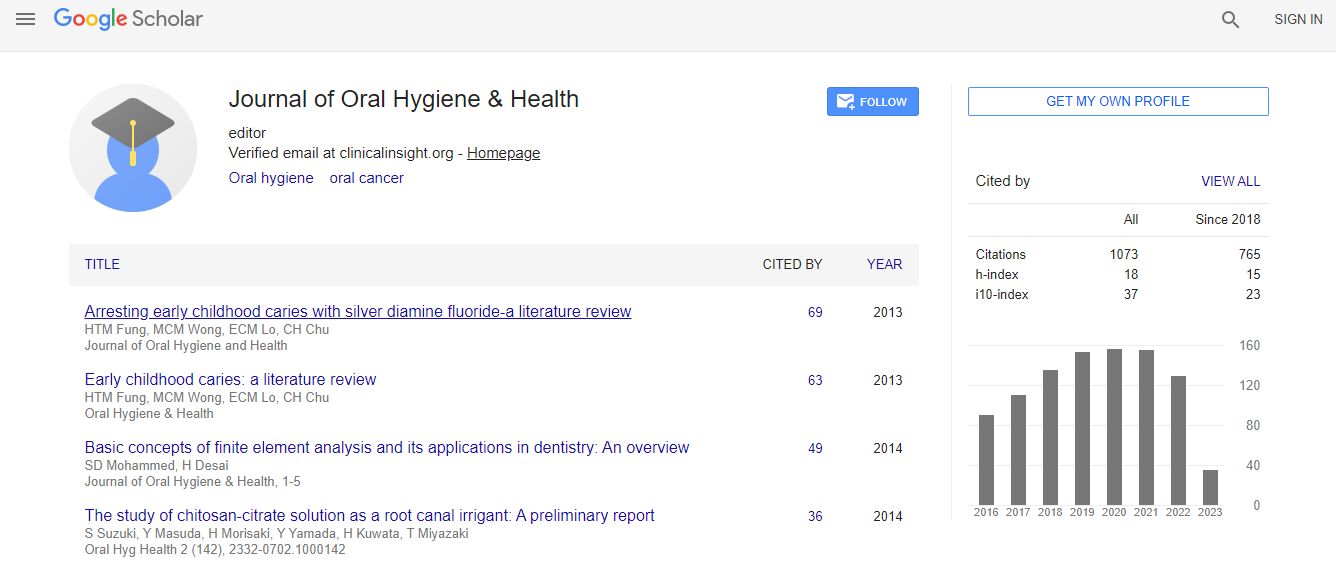Research Article
The Study of Chitosan-Citrate Solution as a Root Canal Irrigant: A Preliminary Report
Shigenori Suzuki1, Yoshiko Masuda1*, Hirobumi Morisaki2, Yoshishige Yamada1, Hirotaka Kuwata2 and Takashi Miyazaki3
1 Division of Endodontology, Department of Conservative Dentistry, Showa University School of Dentistry, Japan
2 Department of Oral Microbiology and Immunology, Showa University School of Dentistry, Japan
3 Division of Oral Biomaterials and Technology, Department of Conservative Dentistry, Showa University School of Dentistry, Japan
- *Corresponding Author:
- Yoshiko Masuda
Showa University School of Dentistry
2-1-1 Kitasenzoku, Ota-ku
Tokyo 145-8515, Japan
Tel: +81337871151(Ext 247)
Fax: +81337871229
E-mail: yoshik@dent.showa-u.ac.jp
Received Date: June 05, 2014; Accepted Date: June 21, 2014; Published Date: June 24, 2014
Citation: Suzuki S, Masuda Y, Morisaki H, Yamada Y, Kuwata H, et al. (2014) The Study of Chitosan-Citrate Solution as a Root Canal Irrigant: A Preliminary Report. J Oral Hyg Health 2:142. doi:10.4172/2332-0702.1000142
Copyright: © 2014 Suzuki S, et al. This is an open-access article distributed under the terms of the Creative Commons Attribution License, which permits unrestricted use, distribution, and reproduction in any medium, provided the original author and source are credited.
Abstract
Objective: Citric acid has been reported removal of smear layer, low antibacterial property, low cytotoxicity. Although the citric acid alone has few used as a root canal irrigant, citric acid formulation with antibacterial effect such as MTAD and Tetraclean has already produced. However, these formulations tended to produce bacteria resistant to antibiotics such as tetracycline and others.
Chitosan have been reported broad spectrum of antibacterial properties, high chelating ability for various metal ions in acidic conditions, biocompatibility and biodegradability. Therefore, we focused on citric acid as a solution to dissolve chitosan. The purpose of this study was to determine whether chitosan-citrate solution shows antibacterial properties against Enterococcus faecalis and removes the smear layer when used as a root canal irrigant.
Methods: E. faecalis (4532D) was incubated in brain-heart infusion broth. Chitosan-citrate solution was then added to the bacterial inoculum for 5, 15, 30, and 60 min. Survival rates of E. faecalis were statistically analyzed using one-way repeated measures ANOVA and Tukey test. Extracted teeth were used for this experiment. The middle third of the root was cut longitudinally, and all specimens were immersed in chitosan-citrate solution until an antibacterial effect was obtained. All specimens were examined under scanning electron microscopy. The number of open dentin tubules was determined for evaluation of smear layer removal. One-way repeated measures ANOVA and Tukey test were used for analysis of open dentin tubules.
Results: The antibacterial effect of chitosan-citrate solution was achieved at 5 min. Furthermore, chitosan-citrate solution resulted in a significantly greater reduction of the survival rate than 10% citric acid after 5 min of application (p<0.01). The smear layer was also removed after immersion in chitosan-citrate solution for 5 min. Chitosan-citrate solution removed significantly more of the smear layer than 10% citric acid (P<0.05).
Conclusion: In conclusion, chitosan-citrate solution showed antibacterial activity and enabled removal of smear layer. As this ability depended on chitosan, it is considered that the action was enhanced by chitosan. Chitosancitrate solution has been indicated as a possible root canal irrigant.

 Spanish
Spanish  Chinese
Chinese  Russian
Russian  German
German  French
French  Japanese
Japanese  Portuguese
Portuguese  Hindi
Hindi 
